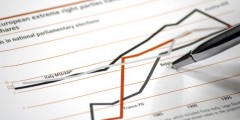Lesson 6 – Forex Technical Analysis
 Technical analysis is a method widely used in stock markets and other traditional markets. They use price history and a series of algorithms in their attempt to predict future prices. You can find on the market different methods and algorithms for predicting the market’s price, but in the end they will always base their methods on past price movements. Technical analysis, however, is a bit different.
Technical analysis is a method widely used in stock markets and other traditional markets. They use price history and a series of algorithms in their attempt to predict future prices. You can find on the market different methods and algorithms for predicting the market’s price, but in the end they will always base their methods on past price movements. Technical analysis, however, is a bit different.
The first method used by technical analysis is using the technical indicators. Usually a technical indicator is nothing more than a graphical representation display somewhere on the screen. Usually, the price is represented. The most notorious example is the MACD indicator.
Other methods can use measure resistance and support or trend lines. These methods are based on analyzing the chart and observing the recent history. The method is trying to find a pattern for price movements. Usually the price either follows a certain pattern or it oscillates between a minimum and a maximum. If the price follows a pattern, you can predict where it will go by using trend lines. If it bounces forth and back between a minimum and a maximum then using resistance and support lines you can predict when it will change its direction.
Technical analysis can be very helpful but its predictions are not flawless. Only you can decide if to trust a technical analysis and make a trade or wait for another opportunity. On the market you can find a wide variety of indicators and technical tools. Since most traders have access to them, the slightest difference in interpretation can make a huge difference on transactions. If some traders want similar price range and they all try to buy at that point then the price can bounce quite drastically in a short period of time.
Technical analysis is different from one trader to another. Each individual has its own desires, needs and interpretations. Every trader has its own goals too, so they have different ideas about how these goals can be reached and how to set up their indicators. All these differences make the individual’s trading system. Take any number of traders and you will see that, even if they use similar tools, the results will never be the same. The current market still works only due to all these differences.
For forex trading technical analysis is quite useful. It will only show a small part of the market but you can learn a lot about trading from it. Understanding technical data will help you read the charts better and you will develop certain skills and thus you will see faster when a price movements appears.
Technical Analysis
Technical analysis refers to the study of indicators and charts in order to determine the future price movement based on the past price variation. The technical analysis is quite different from fundamental analysis, since technical analysis uses mathematical techniques and charts to examine different aspects of price movement. Due to the development of Internet, all these indicators and charts are widely available to every user connected to the Internet, and not just for professional traders and brokers, like was in the past.
Charts will give you plenty of information about any price movement regarding a certain currency, if you know how to read them. Most traders consider that a chart tells the story of the currency it represents. Since there are more than 50 technical indicators you, as a trader, can get access to a huge amount of information about currency movement. From any historical analysis you can predict the future movement of that currency.
A good trader will certainly search a trend line. Trend lines always show the price movement of a certain currency (down or up). If you can find a trend, then you can determine quite accurate the price movement. A trend is always a good friend in this type of business, and all traders rely on them for future price predictions.
Technical indicators are used to study some particular aspects of a certain currency. These indicators are quite similar with the well known economic reports since they study the movement and health of a currency in comparison with economic reports that study the growth and health of a certain economy.
